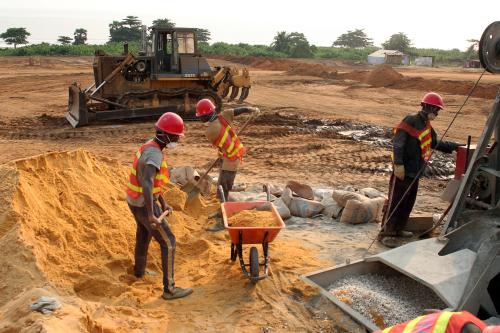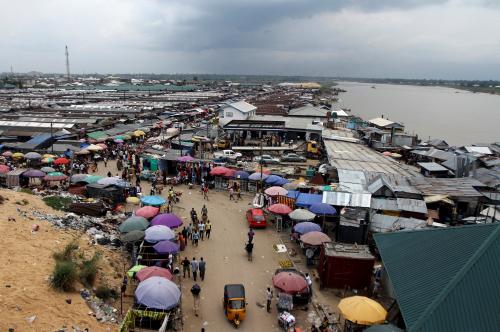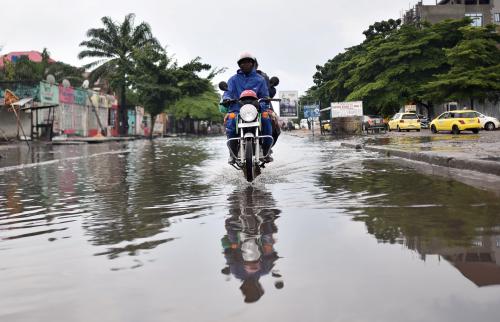The International Monetary Fund’s (IMF) latest World Economic Outlook (WEO) report suggests that global gross domestic product (GDP) growth is on the rebound from its 2016 level of 3.2 percent—its lowest growth rate since the global financial crisis. As seen in Table 1.1, the report states that in 2017 and 2018, global GDP growth is expected to rise to 3.6 percent and 3.7 percent, respectively, as growth outcomes in the first half of 2017 were better than anticipated for the euro area, Japan, emerging Asia, emerging Europe, and Russia. The positive performance in the aforementioned countries is expected to offset downward revisions of GDP growth for the United States and United Kingdom due to policy uncertainty in the U.S. and slower-than-anticipated growth in the U.K. during the first half of 2017.
Meanwhile, sub-Saharan Africa, which grew at 1.4 percent in 2016, is expected to see higher growth in 2017 (2.6 percent) and 2018 (3.4 percent) although significant differences exist across countries. Downside risks remain high as some of the continent’s largest economies have delayed policy adjustments to lower oil revenues, leading to fiscal deficits, weak external positions, and vulnerable financial sectors. The near-term outlook is most promising for fuel-importing countries in sub-Saharan Africa, which are expected to grow at aggregates of 3.9 percent in 2017 and 4.4 percent in 2018. In the long term, GDP growth in sub-Saharan Africa is expected to continue rising, however, it may barely surpass population growth as fiscal consolidation needs may detract from public spending and have adverse side effects on growth, the WEO argues.
 Source: IMF REO October 2017.
Source: IMF REO October 2017.
According to the IMF, nearly 75 percent of the world economy (measured by GDP at purchasing power parity) is currently experiencing an upswing in GDP growth although some countries—especially emerging and low-income commodity exporters and countries experiencing civil or political unrest—are still struggling. Negative effects from climate change, such as drought, flooding, temperature shocks, and other extreme weather events, are also worsening economic performance in some countries, with low-income countries suffering disproportionately. To explore the impacts of climate change on the global economy, an analytical chapter (Chapter 3) in this year’s WEO specifically focuses on the economic and social costs of climate change and possible policies and mechanisms to help low-income countries mitigate and adapt to climate change.
Notably, Chapter 3 highlights that countries projected to be severely affected by a rise in temperature are home to nearly 60 percent of the current global population; however, they comprise only about one-fifth of the global economy 2016. In 2100, these countries are expected to be home to more than 75 percent of the global population. As seen in the maps below, a 1 degree Celsius increase in temperature is expected to most severely diminish real per capita output in areas of the world where the majority of the world’s population lives, including in Africa, Latin America, and Asia. The main channels of influence of weather on economic activity are through agricultural output, as well as broader impacts such as labor productivity, mortality, health, and conflict.


 Source: IMF REO October 2017.
Source: IMF REO October 2017.
To mitigate the effects of climate change, the report suggests that countries implement policies to build buffers and safety nets, invest in targeted infrastructure projects, and promote the adoption of appropriate technologies to support vulnerable populations in light of growing weather shocks. Advancing policies that promote structural economic transformation—the transition from an agriculture-based to industry- and services-based economy—could also make economies less vulnerable to climate shocks. Countries can also adopt policies that make capital and labor markets more flexible, which can help countries recover faster from shocks. They can adopt mechanisms that transfer and share risks posed by climate change through financial markets. For instance, in Africa, African Risk Capacity is a multilateral risk-sharing mechanism that helps 35 African countries fund emergency response by providing timely payouts in the immediate aftermath of a disaster. This risk-sharing tool and other insurance mechanisms can help limit the financial burden of natural disasters.
The Brookings Institution is committed to quality, independence, and impact.
We are supported by a diverse array of funders. In line with our values and policies, each Brookings publication represents the sole views of its author(s).







Commentary
Figures of the week: IMF predicts a pickup in global and sub-Saharan African growth, though warns of climate change threats
October 12, 2017